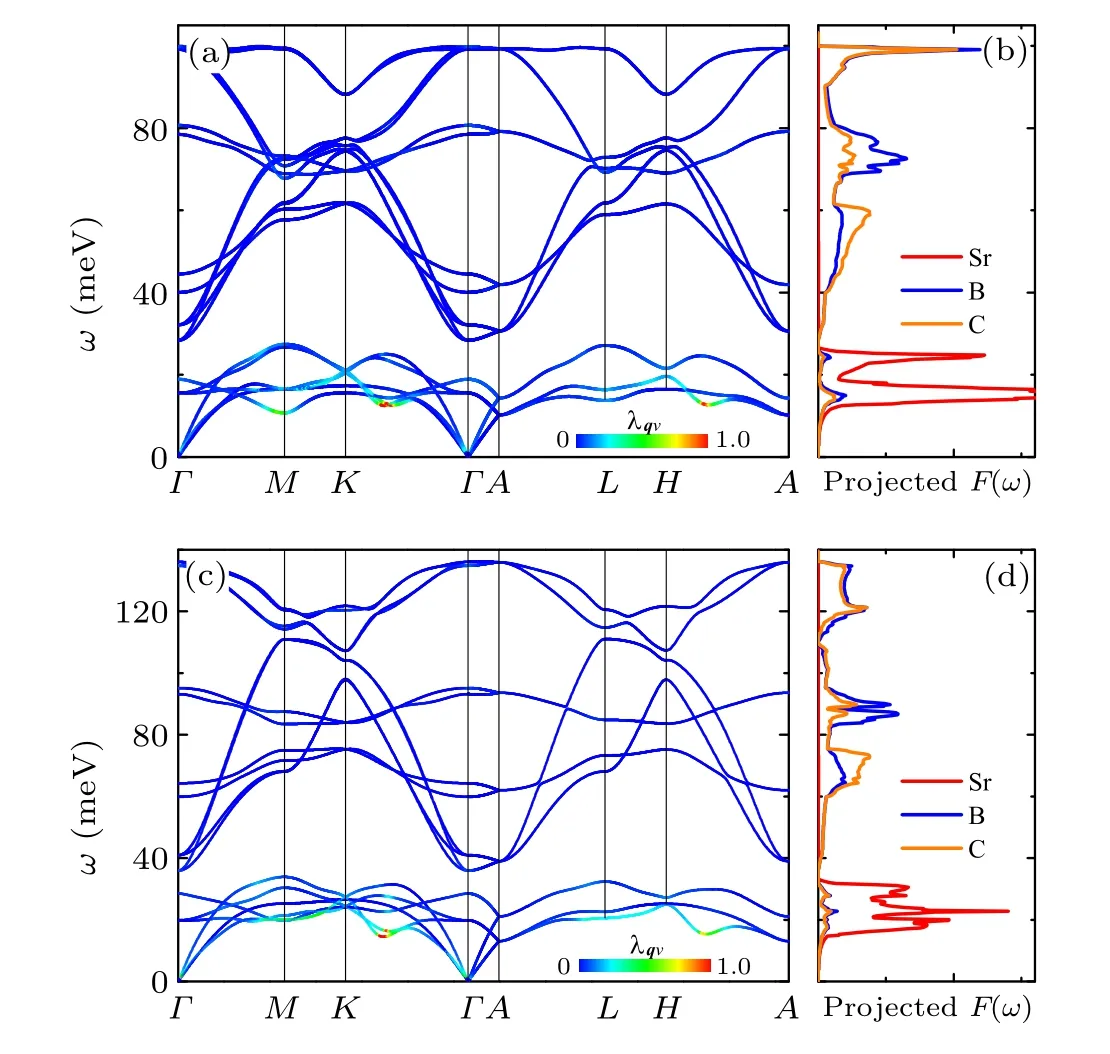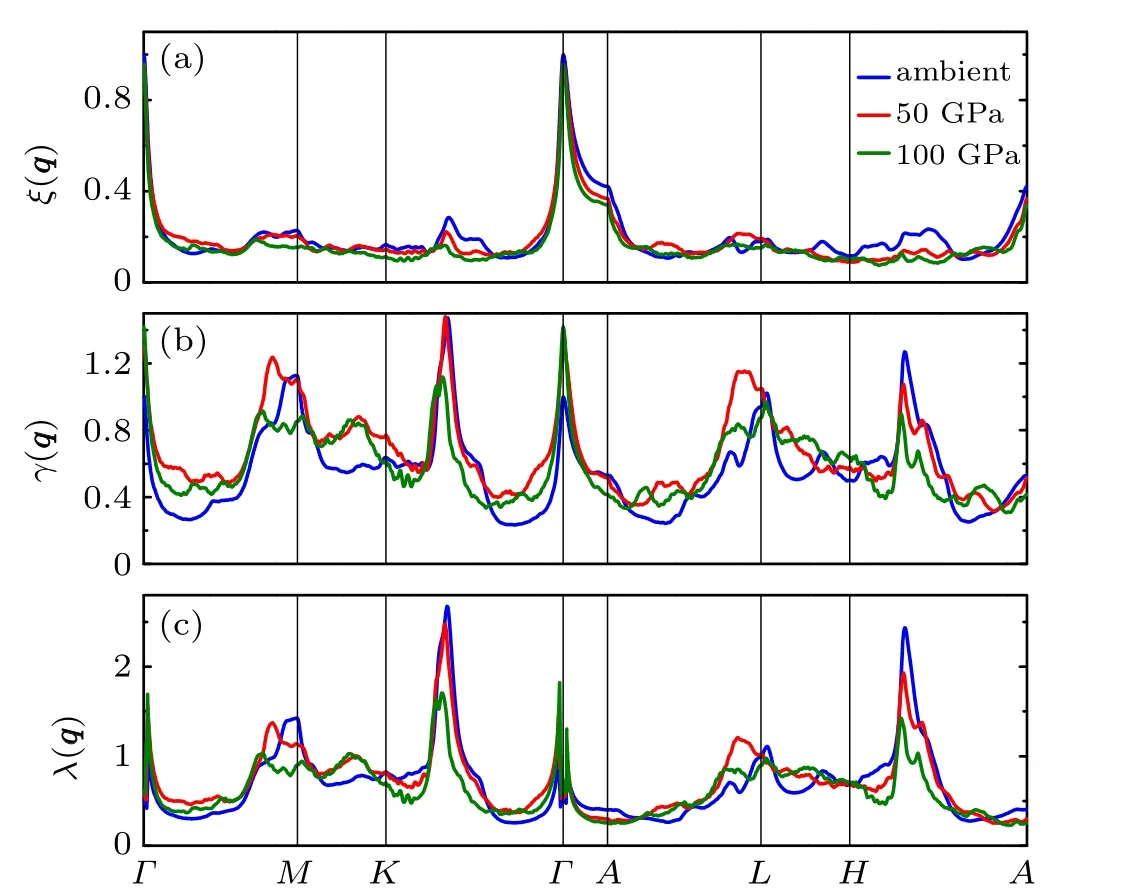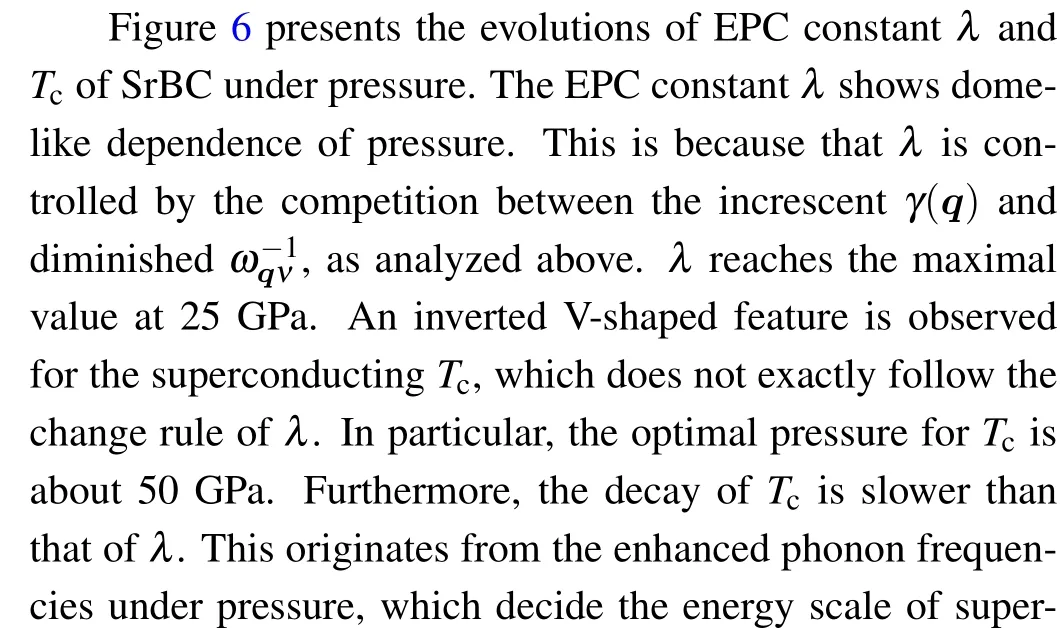Inverted V-shaped evolution of superconducting temperature in SrBC under pressure*
Ru-Yi Zhao(赵如意) Xun-Wang Yan(闫循旺) and Miao Gao(高淼)
1Department of Physics,School of Physical Science and Technology,Ningbo University,Ningbo 315211,China
2College of Physics and Engineering,Qufu Normal University,Qufu 273165,China
Keywords: SrBC,phonon-mediated superconductivity,anisotropic Eliashberg theory,first-principles calculation,maximally localized Wannier functions
1. Introduction
The outstanding superconductivity of MgB2stems from its unique electronic structure, whereas both theσ-bonding bands andπ-bonding band cross the Fermi level simultaneously.[1-3]The underlying superconducting mechanism in MgB2has been well understood by the strong-coupling anisotropic Migdal-Eliashberg theory. The consensus is that MgB2is a two-gap phonon-mediated superconductor.[4,5]Finding MgB2-type superconductor has drawn lots of attention both theoretically and experimentally.A fascinating analogue is hole-doped LiBC, namely, LixBC.By introducing Li vacancies, theσbands were predicted to be partially filled, leading to a highTcabout 100 K.[6]However, the Li vacancies cause significant lattice distortion,which impedes the metallization of theσbands.[7]As a result,no superconducting transition was observed in LixBC.[8-11]To avoid the formation of Li vacancies, introducing excess boron was proposed to be an alternative way to realize hole doping of LiBC, for example, Li2B3C, Li3B4C2,[12]and Li4B5C3.[13]We further systematically studied the electronphonon coupling (EPC) in free-standing and strained trilayer film LiB2C2.[14]It was found that the highestTccan be achieved is 125 K for LiB2C2film under biaxial tensile strain of 8%.
In addition to doping holes, Haqueet al. suggested that doping electrons into LiBC by replacing Li with alkalineearth metalM(M=Mg, Ca, Sr, or Ba) may induce superconducting states.[15]For example, theTcwas estimated to be 51 K for MgBC with McMillan-Allen-Dynes formula.[15]It was shown by first-principles calculation thatMBC has two energy bands crossing the Fermi level, similar to the case in MgB2. Hence, it is necessary to determine theTcthrough self-consistently solving the anisotropic Eliashberg equations, rather than using the semi-empirical McMillan-Allen-Dynes formula. Very recently,utilizing the CALYPSO structure prediction method, SrBC was found to be stable at 50 GPa.[16]In particular,SrBC has been successfully synthesized in experiment.[16]It is thus quite interesting to accurately investigate the phonon-mediated superconductivity in SrBC and its evolution under pressure. Especially, whether the two metallic bands of SrBC can give rise to the high-Tctwo-gap superconductivity as in MgB2.
In this work, the electronic structure, lattice dynamics,EPC,and superconductivity in SrBC are studied from ambient pressure to 100 GPa by means of the first-principles calculations. The lattice constants of SrBC show excellent isotropy during compression. This most likely originates from the appearance of interstitial electronic states between two boroncarbon sheets. B-2pzorbital and the interstitial states contribute mostly to the density of states around the Fermi level.We find that Sr phonons possess strong coupling with B-2pzorbital and interstitial states. Through Wannier interpolation technique, the EPC constantλis accurately calculated to be 0.709 at ambient pressure. Interestingly, there is a domelike feature forλwith the increase of the applied pressure.This can be explained by the competition between enhanced electron-phonon matrix element and hardened phonons. By solving the anisotropic Eliashberg equations, SrBC is determined to be a two-gap superconductor. TheTcshows an inverted V-shaped relationship with pressure. SrBC can achieve its maximalTcof 22 K under 50 GPa. Below 50 GPa,Tcalmost increases linearly, with a positive rate of 0.18 K/GPa.Contrarily,a negative slope of-0.08 K/GPa is found beyond 50 GPa. The slightly different pressure dependence forλandTcis due to the enlarged energy scale of electron pairing, as indicated by the characteristic phonon frequency.
2. Methods
In our calculations, the first-principles package,Quantum-ESPRESSO, was adopted.[17]We calculated the electronic states and phonon perturbation potentials[18]using the generalized gradient approximation (GGA) of Perdew-Burke-Ernzerhoff formula[19]and the optimized normconserving Vanderbilt pseudopotentials.[20]After convergence test, the kinetic energy cut-off and the charge density cutoff were chosen to be 80 Ry and 320 Ry, respectively. The charge densities were calculated on akmesh of 24×24×12 points in combination with a Methfessel-Paxton smearing[21]of 0.02 Ry. The dynamical matrices and the perturbation potentials were computed on a 8×8×4 mesh, based on the density-functional perturbation theory.[22]Ten randomlycentered s-type Gaussian functions were used as the initial guess to construct the maximally localized Wannier functions(MLWFs).[23]When checking the convergence of EPC constantλ,the phonon grid was fixed to 24×24×12 points,the electron grid was extended from 24×24×12,to 36×36×18,to 48×48×24, and finally to 72×72×36 points.[24]The Diracδ-functions for electrons and phonons were smeared out by a Gaussian function with the widths of 80 meV and 0.5 meV, respectively. An electron grid of 48×48×24 points was employed in solving the anisotropic Eliashberg equations.[24-26]The number of Matsubara frequency grid points was chosen to be 300. The highest temperature with non-zero superconducting gap corresponds to the transition temperature. In practice,the threshold value for nonvanishing gap was set to 0.01 meV during the numerical iterations.
3. Results and discussion
SrBC is isostructural to LiBC,in which the boron-carbon sheet forms a honeycomb lattice, while Sr atoms occupy the hollow sites between two adjacent boron-carbon sheets. At ambient pressure, the lattice constants are optimized asa=3.0122 ˚A andc=8.9909 ˚A,in excellent agreement with previous results.[15,16]The band structure of SrBC is shown in Fig. 1(a). Unlike semiconducting LiBC, SrBC is a metal, in which two bands crossing the Fermi level. Particularly, the energy gap that found in LiBC is absent near the Fermi level.Thus, the electronic structure of SrBC can not be simply regraded as the rigid shift of Fermi level of LiBC.There is strong hybridization among the 2pxand 2pyorbitals of boron and carbon atoms, as revealed by the peak of the orbital-resolved density of states (DOS) around-3.5 eV [Fig. 1(b)]. The hybridization that occurs in the two-dimensional honeycomb sheet will generate bondingσand antibondingσ*bands. The maximum of theσbands is about-1.4 eV,corresponding to the dispersionless bands alongΓ-Aline. While,the energy of theσ*bands is well above the Fermi level. As a consequence,the contribution toN(0) (DOS at the Fermi level) from 2pxand 2pyorbitals of boron and carbon atoms is tiny. The overlapping between the 2pzorbitals of carbon and boron atoms will engenderπandπ*bands. As we see, there is a pseudo gap for pz-related DOS, roughly around-1.5 eV [Fig. 1(b)].These bands can be respectively assigned toπandπ*bands below and above the pseudo gap. Therefore, theπ*bands(mainly from the B-2pzorbital) make a large contribution toN(0). Moreover,Sr-5s orbital occupies nonnegligible proportion ofN(0). These observations are different from the conclusion drawn in Ref.[15],in which the partially filled energy bands were assigned toσandπbands,respectively.
Detailed analysis shows that the summation of orbitalresolved DOS does not match the total DOS near the Fermi level[Fig.1(c)]. Specifically,the orbital-resolved DOS is just about 58.8% of the total DOS. This indicates that there exist copious interstitial states.As confirmed by the integrated local DOS, abundant charge accumulation can be clearly observed in the middle region of two neighboring boron-carbon sheets[Fig.1(g)].We further project the weights of B-2pz,C-2pz,Sr-5s, and interstitial states onto the Fermi surfaces [Figs. 1(h)-1(k)]. The two incompletely filled energy bands yield two Fermi surfaces. The Fermi-surface states close to theKpoint mainly comprise of the B-2pzorbital [see the bottom panel of Fig. 1(h)]. Sr-5s orbital contributes mostly to the Fermi pocket surrounding theΓpoint. The interstitial states dominate the contribution to the hexagonal cylinder-like Fermi surface and states near theMpoint. We also map thek-resolved EPC constant,i.e.,λknon the Fermi surfaces. Obviously,the interstitial states on the hexagonal cylinder-like Fermi surface strongly couple with phonons[Fig.1(l)].
Under 50 GPa, the lattice constants of SrBC are calculated to bea=2.7900 ˚A andc=8.3331 ˚A.Interestingly,aandcshrink about 7.38%and 7.32%,respectively,compared with the data obtained at ambient pressure.This means that SrBC is almost isotropic in compressibility. The isotropy of compressibility can at least retain to 100 GPa, under which the lattice constants are compressed by 11.2%and 11.1%alongaandcaxes,respectively. It is known that layered compounds always exhibit large anisotropy in compressibility, which reflects the bonding nature along different directions in the material. For instance,the compressibility along thecaxis is five times that along theaaxis for LiBC.[27]Similar situation was also reported in MgB2, where the lattice constantcdecreases faster with pressure thana.[28]The greater stiffness along thecaxis of SrBC compared to LiBC is closely related to the presence of interstitial states between boron-carbon sheets. After applying pressure,the band becomes more dispersive[Fig.1(d)]. Consequently, the sharp peaks in DOS are broadened [Fig. 1(e)].There still exist substantial interstitial states,which contribute 38.0% ofN(0) [Fig. 1(f)]. Due to the enlarged band widths,the Fermi pocket around theΓpoint disappears. The weights of B-2pz,C-2pz,Sr-5s,and interstitial states on the Fermi surfaces behavior similarly to the case under ambient pressure[Figs. 1(m)-1(p)]. Remarkably, the EPC is enhanced significantly[Fig.1(q)].

Fig. 1. Electronic structure for SrBC. (a) Band structure under ambient pressure. The red lines and blue circles denote the bands obtained by first-principles calculation and interpolating the real-space Hamiltonian, respectively. The Fermi level is set to zero. (b) Orbital-resolved DOS.(c)Total DOS.(d)Band structure under 50 GPa. (e)Orbital resolved and(f)total DOS under 50 GPa. (g)Isosurface of integrated local density of states from -0.1 eV to 0.1 eV under ambient pressure. The isovalue is selected as 1.0×10-3 e/Bohr3. (h)-(q) The weights of B 2pz, C 2pz, Sr 5s,interstitial states,and momentum-resolved EPC constants on the Fermi surfaces. Here(h)-(l)correspond to the results under ambient pressure,(m)-(q)stand for the datum of 50 GPa.
Figure 2 shows the lattice dynamics of SrBC. Although,SrBC was proved to be stable above 50 GPa,there is no imaginary phonon frequency under ambient pressure[Fig.2(a)]. A small frequency gap at about 25 meV is found. Below the gap,there are six branches of phonons, which can be assigned to the vibration of Sr,due to its greater atomic mass than those of boron and carbon. This is confirmed by the projected phonon DOSF(ω) [Fig. 2(b)]. As reflected byλqν, Sr-associated phonons have strong coupling with electrons, especially the interstitial states. Under 50 GPa,the phonons show markedly hardening[Fig.2(c)],owing to the enhanced interatomic force constants. For example,the highest frequency is amplified by 36.5% with respect to the ambient pressure. Similar to the electronic DOS,the peaks of projectedF(ω)are evidently reduced[Fig.2(d)].The number of Sr-associated phonon modes with sizeableλqνincreases. This will lead to enlarged EPC constant,self-consistent with Fig.1(q).
The Eliashberg spectral functionα2F(ω), totalF(ω),and accumulatedλ(ω)are shown in Fig.3. At ambient pressure,α2F(ω) displays multi-peak characteristics [Fig. 3(a)].Two peaks locate below the frequency gap. By integratingα2F(ω), the EPC constantλis accurately determined to be 0.709. Under 50 GPa, all these peaks ofα2F(ω) are blueshifted, combined with obvious broadening [Fig. 3(b)]. Suppose that the phonon linewidth is unaffected by pressure,thenλqν∝ω-2qν, thus the hardened phonons will cause abatement of EPC. Surprisingly, the heights of the low-frequency peaks abnormally increase. As a result, the EPC constantλis boosted to 0.783,slightly larger than that in MgB2acquired by Wannier interpolation technique.[26,29,30]The low-frequency two peaks dominate the EPC process,since Sr-related phonons already take 80.7% and 86.1% of the totalλunder ambient pressure and 50 GPa,respectively,as marked by the black arrows(Fig.3).

Fig. 2. Lattice dynamics of SrBC. (a) Phonon spectrum with a color representation of λqv and (b) projected phonon DOS generated by quasiharmonic approximation,under ambient pressure. (c)Phonon spectrum and(d)projected phonon DOS under 50 GPa.

Fig. 3. The Eliashberg spectral function α2F(ω), total F(ω), and accumulated λ(ω) under ambient p�ressure (a) and 50 GPa (b). Here λ(ω) is computed using the formula 2α2F(ω′)dω′. Black arrows roughly point out the highest frequencies of Sr phonons under different pressures.
To clarify the physical reason for abnormal rise ofλunder 50 GPa,we calculated the Fermi surface nesting functionξ(q), EPC matrix element weighted nesting functionγ(q),andq-resolved EPC constantλ(q).ξ(q) andγ(q) are computed through


Firstly,we can rule out the nesting functionξ(q)as the main factor that causes amplifiedλ, sinceξ(q) shows overall reduction with the increase of pressure[Fig.4(a)]. Interestingly,γ(q)is significantly improved,especially under 50 GPa,compared with that at ambient pressure [Fig. 4(b)]. It has been demonstrated that the phonons are hardened under pressure.This is harmful to the enlargement of EPC constantλ,according to Eq.(3), whereasωqνis the denominator. As shown in Fig.4(c), the preponderance inγ(q)under pressure is gradually condensed inλ(q).However,the EPC strength ofλunder 50 GPa still overwhelms that under ambient pressure. Hence,the increase ofλunder 50 GPa can be attributed to the enhancement of EPC matrix elements close to the Fermi level,i.e.,γ(q). While, the maximal phonon frequency reaches 159.0 meV under 100 GPa. This means that there will be a drop inλat higher pressure, due to the competition between increscentγ(q) and diminished[see Eqs. (2) and (3)].This is just the case for 100 GPa. The detailed change rule ofλis given in Fig.6.

Fig. 4. Comparisons of nesting function ξ(q), EPC matrix element weighted nesting function γ(q), and q-resolved EPC constant λ(q) under different pressures.
By solving the anisotropic Eliashberg equations, we can obtain the superconducting transition temperature and the distribution of superconducting gaps on the Fermi surfaces[Fig. 5]. Here, the Coulomb pseudopotentialμ*was set to a standard value of 0.10.[31,32]SrBC is a two-gap superconductor,whoseTcis about 13 K under ambient pressure[Fig.5(a)].At 5 K,the average values for these two superconducting gaps are computed to be 1.98 meV and 1.14 meV,respectively. The higher superconducting gap mainly locates on the hexagonal cylinder-like Fermi surface [Fig. 5(c)]. While, the lower gap stems from the Fermi surface close to the boundaries of the Brillouin zone [Fig. 5(d)]. The distributions of Δknare in agreement with the weights ofλkn[Fig.1(l)]. Under 50 GPa,these two gaps are enlarged to 3.79 meV and 2.38 meV, respectively [Fig. 5(b)], resulting in a boostedTcof 22 K. The distributions of Δknare similar to those under ambient pressure[Figs.5(e)and 5(f)].

Fig. 5. Temperature dependence of gap values Δkn on the Fermi surface for SrBC under ambient pressure (a) and 50 GPa (b). The distribution of superconducting gaps on the Fermi surfaces at 5 K for SrBC under ambient pressure(c)-(d)and 50 GPa(e)-(f).



Fig. 6. Calculated superconducting transition temperatures of SrBC under different pressures. Here and represent the critical temperatures determined by solving the anisotropic Eliashberg equations and the McMillan-Allen-Dynes formula,respectively. The pressure dependence of EPC constant λ is also given.
The pressure dependence ofTcfor SrBC is infrequent among phonon-mediated superconductors. For MgB2,Tcdecreases quasi-linearly under low pressure with solpe dTc/dPbetween-0.8 K/GPa and-2.0 K/GPa.[34-37]Under higher pressure, it was found that theTcfollows a purely quadratic drop.[34]Especially, theTcof MgB2has already been reduced to 20.9 K at 19.2 GPa.[38]The physical reason for degressiveTccan by explained by a combination of hardened phonons and depressedN(0), particularly the phonons.[39]In contrast, an enhancement ofTcwas reported in MgB2due to phonon softening under tensile strain.[40]The transition temperatures of elemental superconductors,examplified by Al[41]and Pb,[42]also decrease monotonically with pressure. Ca and Y are not superconductive under ambient pressure. While,superconducting transitions in Ca and Y show positive dependence on high pressure. In particular, the transition temperatures can achieve 19.5 K[43]and 25 K,[44]under 115 GPa and 161 GPa,respectively.The superconductivity of rare-earth metals under high pressure has also been extensively studied,such as in La. Under ambient pressure,La takes either double hexagonal-close-packed (dhcp) phase or face-centered cubic(fcc) phase, withTcbeing 5 K and 6 K.[45,46]However, the behavior ofTcis more complicated under pressure,closely related to the phase transition. For example,theTcis firstly enhanced after the occurrence of structural phase transition into a distorted fcc structure near 5.4 GPa. Notable oscillation inTccan be observed for the distorted fcc phase,with the highestTcbeing about 13 K.[47,48]Further increasing the pressure,La undergos distorted fcc to fcc, and fcc to another distorted fcc phase transitions. The transition temperature basically shows monotone decline above 50 GPa, and finally goes down to 2.2 K at 140 GPa.[49]
For MgB2, it was suggested that the enlargement of lattice constant along thecaxis can increaseN(0) and shift theσband upward.[50]Correspondingly, the hole number in theσband increases and a higherTccan be expected. Moreover, reducing the lattice constant alongaaxis has similar effect with enlarging thecaxis. Since SrBC achieves its highestTcunder 50 GPa. Followed the prediction in MgB2,we further examine the possibility to enhance theTcby respectively modulating the lattice constants along different directions. For simplicity, the lattice constants of SrBC under 50 GPa are labelled asa0andc0. Specifically, we systematically investigate the phonon-mediated superconductivity under four situations, i.e.,c=1.15c0,c=0.90c0,a=1.15a0,anda=0.85a0. When adjusting the lattice constant along thecaxis,thea-axis cell parameter is unchanged,and vice versa.Similar to the case of MgB2,we find that the maximum ofσbands increases by 0.47 meV and 0.61 meV forc=1.15c0anda=0.85a0,respectively. While,it decreases by 0.45 meV and 0.43 meV forc=0.90c0anda=1.15a0. Theσbands are still completely filled for all these cases. In particular,we find that the dependence ofTcin SrBC on the lattice constants is more complicated than that in MgB2. Interestingly, onlyc=0.90c0can boost theTcto a higher value of 31 K among the studied four situations. According to our calculations,we find thatN(0)=0.961 states/spin/eV/cell,λ=1.052,andωlog=25.66 meV forc=0.90c0.The enhancedTcis probably related to the aggrandizement ofN(0).
4. Conclusion
In summary, we have presented the first-principles results of electronic structure, lattice dynamics, EPC, and phonon-mediated superconductivity for layered SrBC. Although, SrBC is isostructural to LiBC,significant differences are unmasked by our calculations. For instance, SrBC is inherently metallic with two partially filled energy bands, in comparison with the insulating nature of LiBC. The electronic states around the Fermi level mainly consist of B-2pzorbital and considerable interstitial states. Moreover,SrBC is isotropic in compression, contrast sharply to LiBC.Based on these observations,SrBC can not be concluded as an electrondoped LiBC-like compound with rigid Fermi-level shifting.The EPC strengthλis accurately determined to be 0.709 under atmospheric pressure. Based on anisotropic Eliashberg theory and Wannier interpolation,we find that SrBC is a two-gap superconductor withTcof 13 K, which is evidently smaller with respect to MgB2. This is because that low-frequency Sr phonons govern the EPC process of SrBC rather than highfrequency bond-stretching boron-related phonon modes as in MgB2.Since SrBC is stable above 50 GPa,we have systematically examined the evolution of superconductivity under pressure. In particular, an inverted V-shaped evolution ofTcis revealed,with the highestTcbeing 22 K at 50 GPa. This phenomenon is scarce among phonon-mediated superconductors,and stems from the balance between enhanced EPC matrix element and hardened phonons.
- Chinese Physics B的其它文章
- Projective representation of D6 group in twisted bilayer graphene*
- Bilayer twisting as a mean to isolate connected flat bands in a kagome lattice through Wigner crystallization*
- Magnon bands in twisted bilayer honeycomb quantum magnets*
- Faraday rotations,ellipticity,and circular dichroism in magneto-optical spectrum of moir´e superlattices*
- Nonlocal advantage of quantum coherence and entanglement of two spins under intrinsic decoherence*
- Universal quantum control based on parametric modulation in superconducting circuits*

